Business Valuation and Analysis Report: Financial Analysis
VerifiedAdded on 2021/06/17
|13
|2859
|19
Report
AI Summary
This report presents a comprehensive business valuation and financial analysis, focusing on the financial performance of a company over a five-year period (2013-2017). The analysis encompasses a detailed examination of various financial ratios, including return on equity (ROE), return on net operating assets (RNOA), financial leverage, net borrowing cost, profitability margin, and asset turnover ratio. The report also delves into cash flow analysis, covering liquidity and solvency ratios, along with cash flow ratios like operating cash flow to sales and asset efficiency. The analysis highlights trends, fluctuations, and significant factors influencing the company's financial health, such as changes in finance costs, employee benefits, raw materials, and cash equivalents. The report provides insights into the company's stability, efficiency, and ability to manage its short-term and long-term obligations, offering a holistic view of its financial standing.
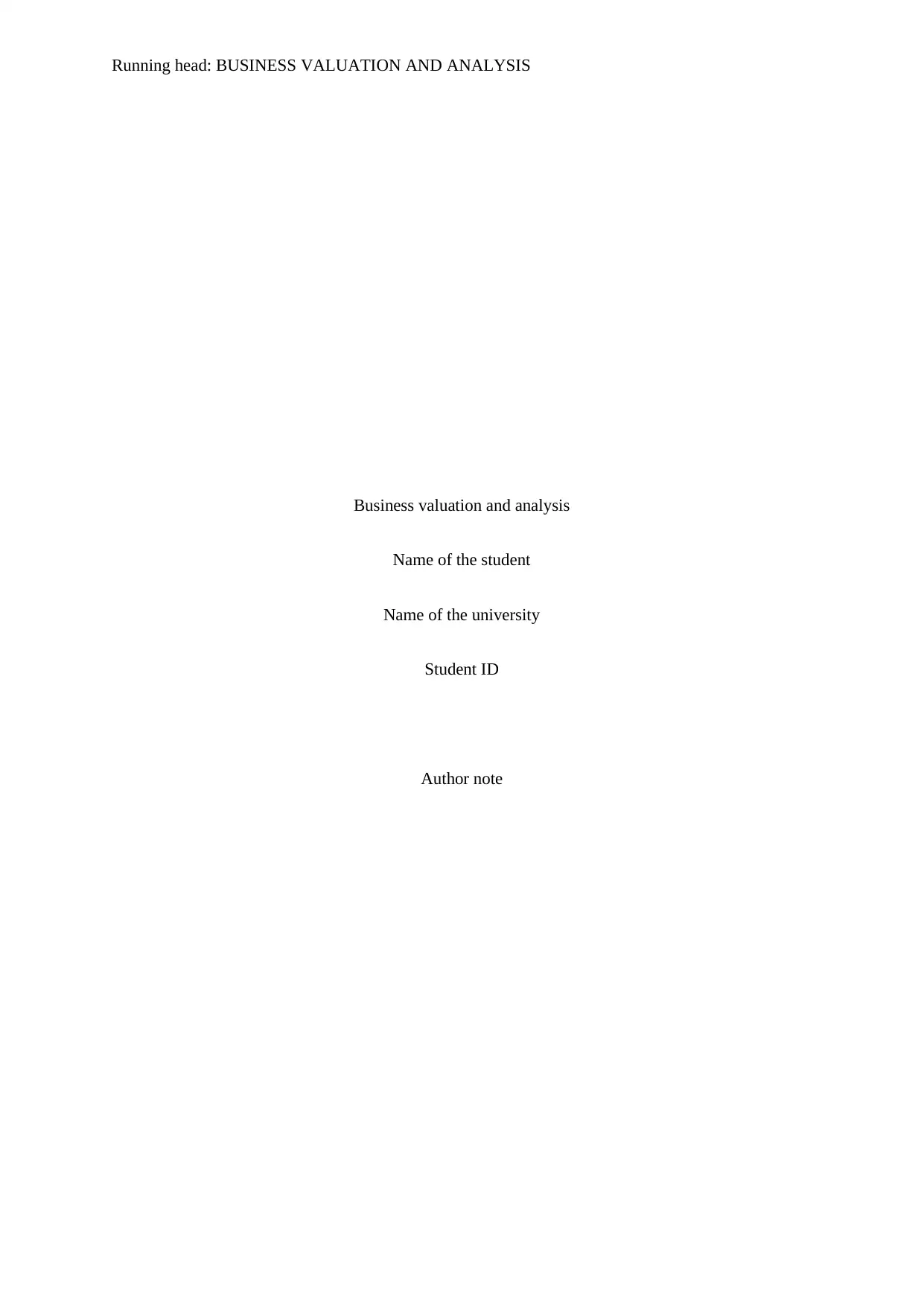
Running head: BUSINESS VALUATION AND ANALYSIS
Business valuation and analysis
Name of the student
Name of the university
Student ID
Author note
Business valuation and analysis
Name of the student
Name of the university
Student ID
Author note
Paraphrase This Document
Need a fresh take? Get an instant paraphrase of this document with our AI Paraphraser
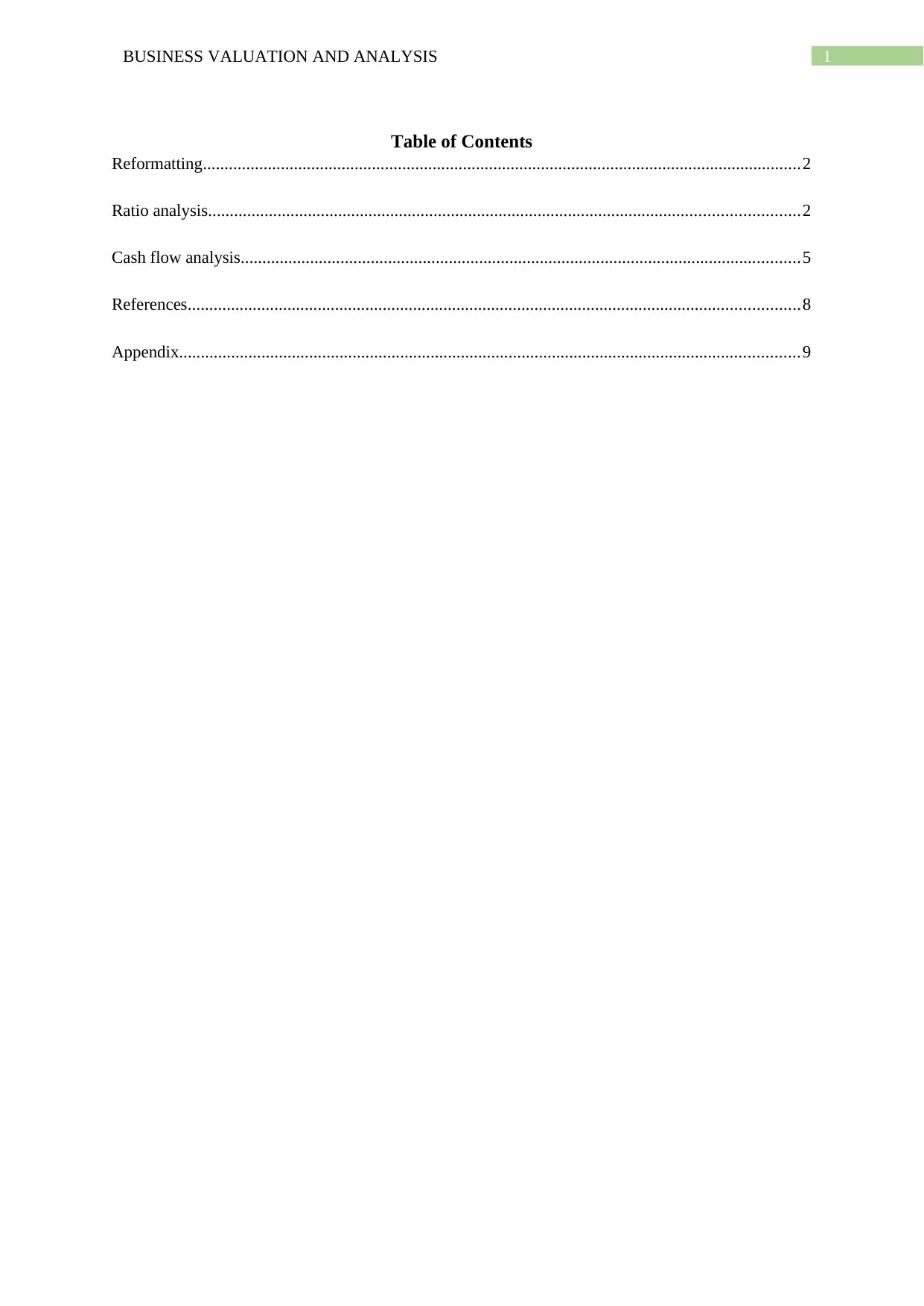
1BUSINESS VALUATION AND ANALYSIS
Table of Contents
Reformatting..........................................................................................................................................2
Ratio analysis........................................................................................................................................2
Cash flow analysis.................................................................................................................................5
References.............................................................................................................................................8
Appendix...............................................................................................................................................9
Table of Contents
Reformatting..........................................................................................................................................2
Ratio analysis........................................................................................................................................2
Cash flow analysis.................................................................................................................................5
References.............................................................................................................................................8
Appendix...............................................................................................................................................9
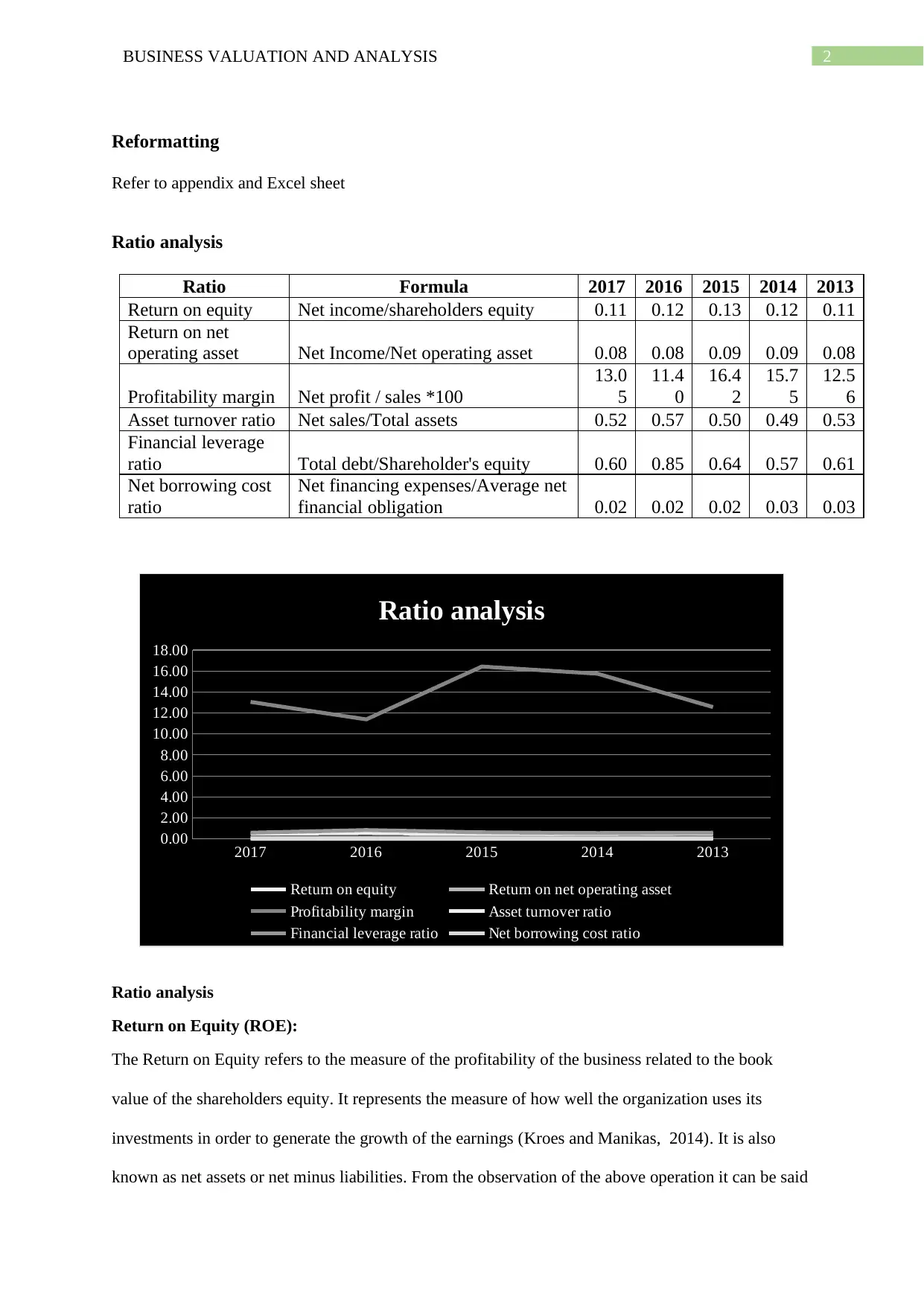
2BUSINESS VALUATION AND ANALYSIS
Reformatting
Refer to appendix and Excel sheet
Ratio analysis
Ratio Formula 2017 2016 2015 2014 2013
Return on equity Net income/shareholders equity 0.11 0.12 0.13 0.12 0.11
Return on net
operating asset Net Income/Net operating asset 0.08 0.08 0.09 0.09 0.08
Profitability margin Net profit / sales *100
13.0
5
11.4
0
16.4
2
15.7
5
12.5
6
Asset turnover ratio Net sales/Total assets 0.52 0.57 0.50 0.49 0.53
Financial leverage
ratio Total debt/Shareholder's equity 0.60 0.85 0.64 0.57 0.61
Net borrowing cost
ratio
Net financing expenses/Average net
financial obligation 0.02 0.02 0.02 0.03 0.03
2017 2016 2015 2014 2013
0.00
2.00
4.00
6.00
8.00
10.00
12.00
14.00
16.00
18.00
Ratio analysis
Return on equity Return on net operating asset
Profitability margin Asset turnover ratio
Financial leverage ratio Net borrowing cost ratio
Ratio analysis
Return on Equity (ROE):
The Return on Equity refers to the measure of the profitability of the business related to the book
value of the shareholders equity. It represents the measure of how well the organization uses its
investments in order to generate the growth of the earnings (Kroes and Manikas, 2014). It is also
known as net assets or net minus liabilities. From the observation of the above operation it can be said
Reformatting
Refer to appendix and Excel sheet
Ratio analysis
Ratio Formula 2017 2016 2015 2014 2013
Return on equity Net income/shareholders equity 0.11 0.12 0.13 0.12 0.11
Return on net
operating asset Net Income/Net operating asset 0.08 0.08 0.09 0.09 0.08
Profitability margin Net profit / sales *100
13.0
5
11.4
0
16.4
2
15.7
5
12.5
6
Asset turnover ratio Net sales/Total assets 0.52 0.57 0.50 0.49 0.53
Financial leverage
ratio Total debt/Shareholder's equity 0.60 0.85 0.64 0.57 0.61
Net borrowing cost
ratio
Net financing expenses/Average net
financial obligation 0.02 0.02 0.02 0.03 0.03
2017 2016 2015 2014 2013
0.00
2.00
4.00
6.00
8.00
10.00
12.00
14.00
16.00
18.00
Ratio analysis
Return on equity Return on net operating asset
Profitability margin Asset turnover ratio
Financial leverage ratio Net borrowing cost ratio
Ratio analysis
Return on Equity (ROE):
The Return on Equity refers to the measure of the profitability of the business related to the book
value of the shareholders equity. It represents the measure of how well the organization uses its
investments in order to generate the growth of the earnings (Kroes and Manikas, 2014). It is also
known as net assets or net minus liabilities. From the observation of the above operation it can be said
⊘ This is a preview!⊘
Do you want full access?
Subscribe today to unlock all pages.

Trusted by 1+ million students worldwide
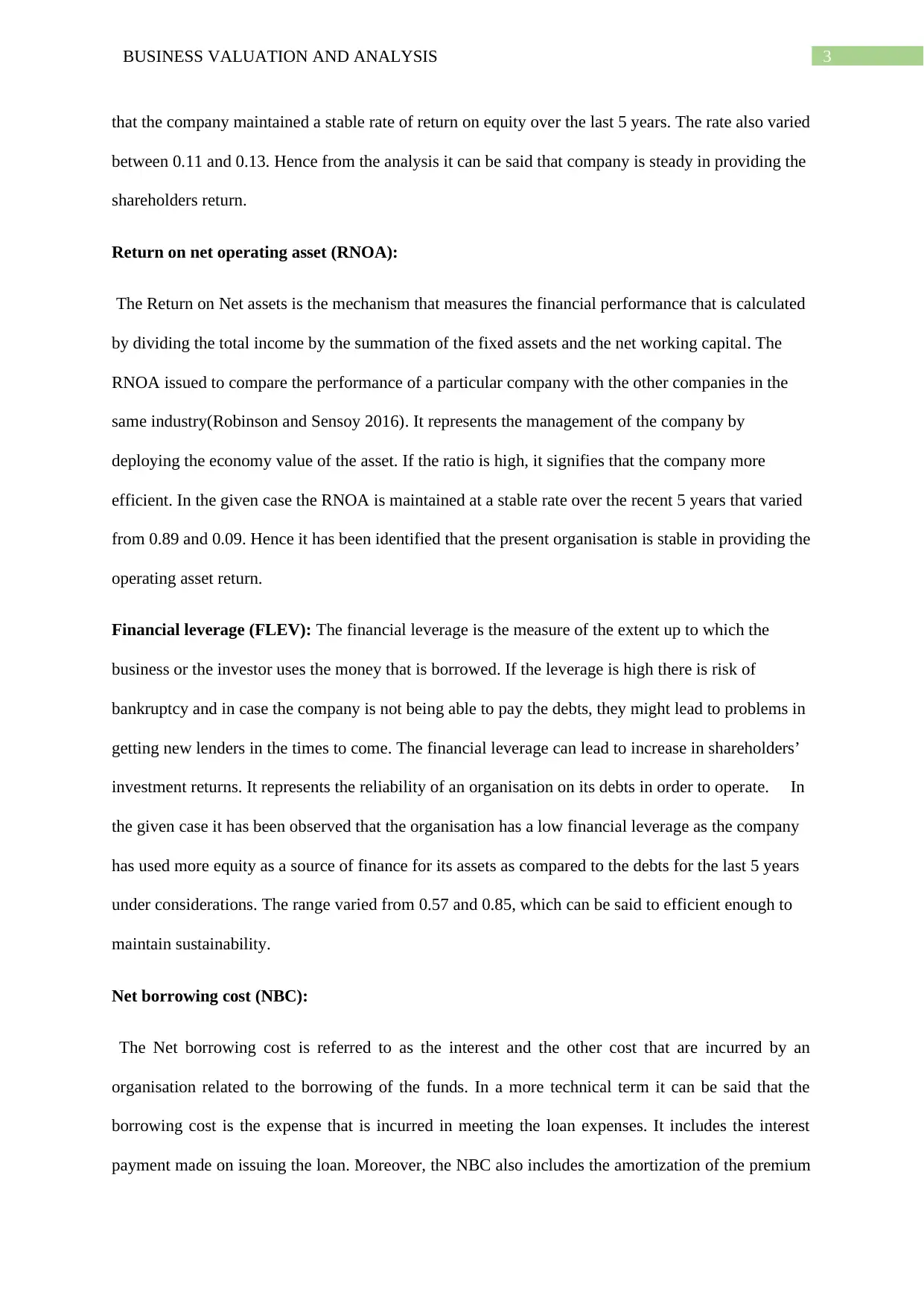
3BUSINESS VALUATION AND ANALYSIS
that the company maintained a stable rate of return on equity over the last 5 years. The rate also varied
between 0.11 and 0.13. Hence from the analysis it can be said that company is steady in providing the
shareholders return.
Return on net operating asset (RNOA):
The Return on Net assets is the mechanism that measures the financial performance that is calculated
by dividing the total income by the summation of the fixed assets and the net working capital. The
RNOA issued to compare the performance of a particular company with the other companies in the
same industry(Robinson and Sensoy 2016). It represents the management of the company by
deploying the economy value of the asset. If the ratio is high, it signifies that the company more
efficient. In the given case the RNOA is maintained at a stable rate over the recent 5 years that varied
from 0.89 and 0.09. Hence it has been identified that the present organisation is stable in providing the
operating asset return.
Financial leverage (FLEV): The financial leverage is the measure of the extent up to which the
business or the investor uses the money that is borrowed. If the leverage is high there is risk of
bankruptcy and in case the company is not being able to pay the debts, they might lead to problems in
getting new lenders in the times to come. The financial leverage can lead to increase in shareholders’
investment returns. It represents the reliability of an organisation on its debts in order to operate. In
the given case it has been observed that the organisation has a low financial leverage as the company
has used more equity as a source of finance for its assets as compared to the debts for the last 5 years
under considerations. The range varied from 0.57 and 0.85, which can be said to efficient enough to
maintain sustainability.
Net borrowing cost (NBC):
The Net borrowing cost is referred to as the interest and the other cost that are incurred by an
organisation related to the borrowing of the funds. In a more technical term it can be said that the
borrowing cost is the expense that is incurred in meeting the loan expenses. It includes the interest
payment made on issuing the loan. Moreover, the NBC also includes the amortization of the premium
that the company maintained a stable rate of return on equity over the last 5 years. The rate also varied
between 0.11 and 0.13. Hence from the analysis it can be said that company is steady in providing the
shareholders return.
Return on net operating asset (RNOA):
The Return on Net assets is the mechanism that measures the financial performance that is calculated
by dividing the total income by the summation of the fixed assets and the net working capital. The
RNOA issued to compare the performance of a particular company with the other companies in the
same industry(Robinson and Sensoy 2016). It represents the management of the company by
deploying the economy value of the asset. If the ratio is high, it signifies that the company more
efficient. In the given case the RNOA is maintained at a stable rate over the recent 5 years that varied
from 0.89 and 0.09. Hence it has been identified that the present organisation is stable in providing the
operating asset return.
Financial leverage (FLEV): The financial leverage is the measure of the extent up to which the
business or the investor uses the money that is borrowed. If the leverage is high there is risk of
bankruptcy and in case the company is not being able to pay the debts, they might lead to problems in
getting new lenders in the times to come. The financial leverage can lead to increase in shareholders’
investment returns. It represents the reliability of an organisation on its debts in order to operate. In
the given case it has been observed that the organisation has a low financial leverage as the company
has used more equity as a source of finance for its assets as compared to the debts for the last 5 years
under considerations. The range varied from 0.57 and 0.85, which can be said to efficient enough to
maintain sustainability.
Net borrowing cost (NBC):
The Net borrowing cost is referred to as the interest and the other cost that are incurred by an
organisation related to the borrowing of the funds. In a more technical term it can be said that the
borrowing cost is the expense that is incurred in meeting the loan expenses. It includes the interest
payment made on issuing the loan. Moreover, the NBC also includes the amortization of the premium
Paraphrase This Document
Need a fresh take? Get an instant paraphrase of this document with our AI Paraphraser
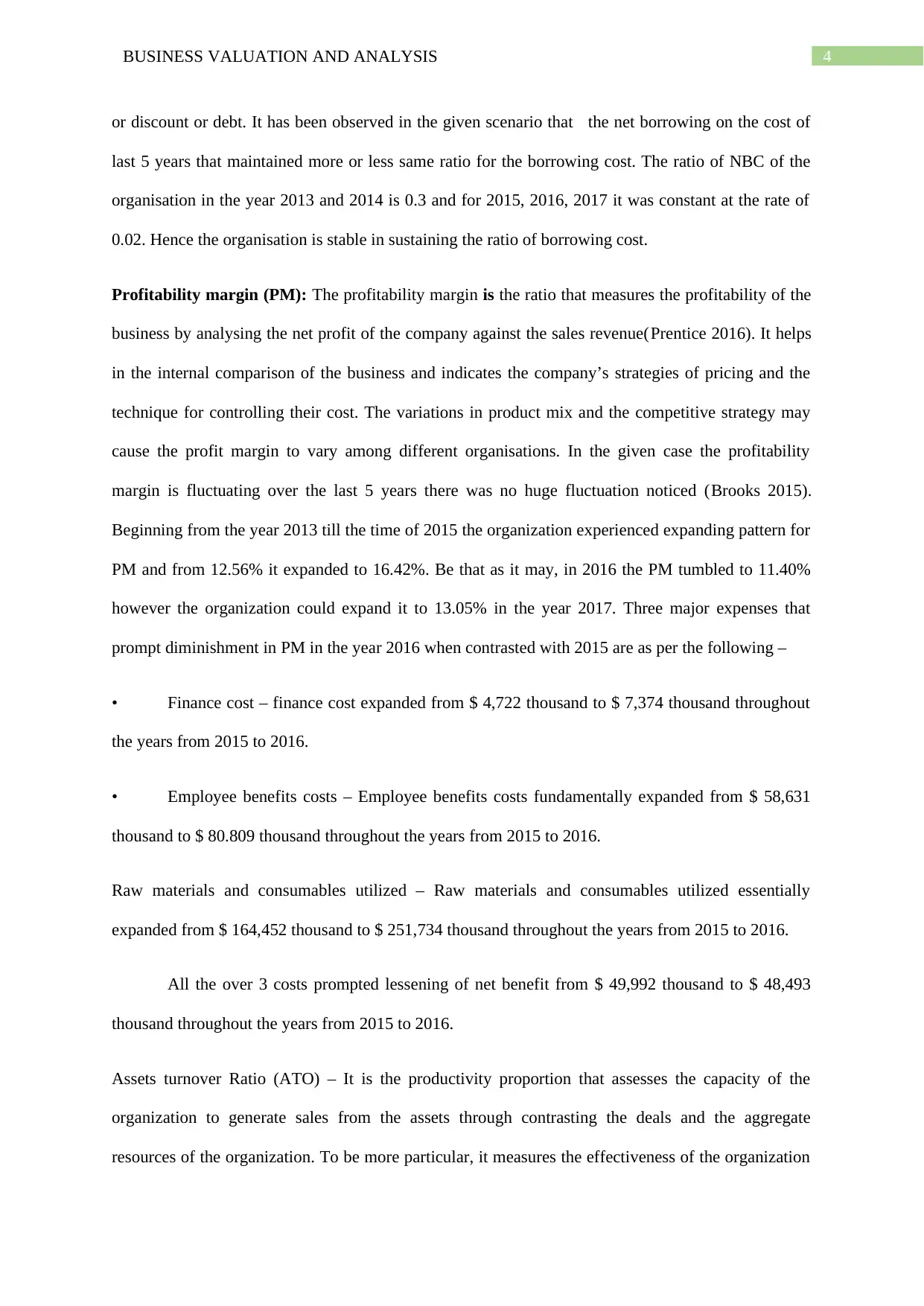
4BUSINESS VALUATION AND ANALYSIS
or discount or debt. It has been observed in the given scenario that the net borrowing on the cost of
last 5 years that maintained more or less same ratio for the borrowing cost. The ratio of NBC of the
organisation in the year 2013 and 2014 is 0.3 and for 2015, 2016, 2017 it was constant at the rate of
0.02. Hence the organisation is stable in sustaining the ratio of borrowing cost.
Profitability margin (PM): The profitability margin is the ratio that measures the profitability of the
business by analysing the net profit of the company against the sales revenue(Prentice 2016). It helps
in the internal comparison of the business and indicates the company’s strategies of pricing and the
technique for controlling their cost. The variations in product mix and the competitive strategy may
cause the profit margin to vary among different organisations. In the given case the profitability
margin is fluctuating over the last 5 years there was no huge fluctuation noticed (Brooks 2015).
Beginning from the year 2013 till the time of 2015 the organization experienced expanding pattern for
PM and from 12.56% it expanded to 16.42%. Be that as it may, in 2016 the PM tumbled to 11.40%
however the organization could expand it to 13.05% in the year 2017. Three major expenses that
prompt diminishment in PM in the year 2016 when contrasted with 2015 are as per the following –
• Finance cost – finance cost expanded from $ 4,722 thousand to $ 7,374 thousand throughout
the years from 2015 to 2016.
• Employee benefits costs – Employee benefits costs fundamentally expanded from $ 58,631
thousand to $ 80.809 thousand throughout the years from 2015 to 2016.
Raw materials and consumables utilized – Raw materials and consumables utilized essentially
expanded from $ 164,452 thousand to $ 251,734 thousand throughout the years from 2015 to 2016.
All the over 3 costs prompted lessening of net benefit from $ 49,992 thousand to $ 48,493
thousand throughout the years from 2015 to 2016.
Assets turnover Ratio (ATO) – It is the productivity proportion that assesses the capacity of the
organization to generate sales from the assets through contrasting the deals and the aggregate
resources of the organization. To be more particular, it measures the effectiveness of the organization
or discount or debt. It has been observed in the given scenario that the net borrowing on the cost of
last 5 years that maintained more or less same ratio for the borrowing cost. The ratio of NBC of the
organisation in the year 2013 and 2014 is 0.3 and for 2015, 2016, 2017 it was constant at the rate of
0.02. Hence the organisation is stable in sustaining the ratio of borrowing cost.
Profitability margin (PM): The profitability margin is the ratio that measures the profitability of the
business by analysing the net profit of the company against the sales revenue(Prentice 2016). It helps
in the internal comparison of the business and indicates the company’s strategies of pricing and the
technique for controlling their cost. The variations in product mix and the competitive strategy may
cause the profit margin to vary among different organisations. In the given case the profitability
margin is fluctuating over the last 5 years there was no huge fluctuation noticed (Brooks 2015).
Beginning from the year 2013 till the time of 2015 the organization experienced expanding pattern for
PM and from 12.56% it expanded to 16.42%. Be that as it may, in 2016 the PM tumbled to 11.40%
however the organization could expand it to 13.05% in the year 2017. Three major expenses that
prompt diminishment in PM in the year 2016 when contrasted with 2015 are as per the following –
• Finance cost – finance cost expanded from $ 4,722 thousand to $ 7,374 thousand throughout
the years from 2015 to 2016.
• Employee benefits costs – Employee benefits costs fundamentally expanded from $ 58,631
thousand to $ 80.809 thousand throughout the years from 2015 to 2016.
Raw materials and consumables utilized – Raw materials and consumables utilized essentially
expanded from $ 164,452 thousand to $ 251,734 thousand throughout the years from 2015 to 2016.
All the over 3 costs prompted lessening of net benefit from $ 49,992 thousand to $ 48,493
thousand throughout the years from 2015 to 2016.
Assets turnover Ratio (ATO) – It is the productivity proportion that assesses the capacity of the
organization to generate sales from the assets through contrasting the deals and the aggregate
resources of the organization. To be more particular, it measures the effectiveness of the organization
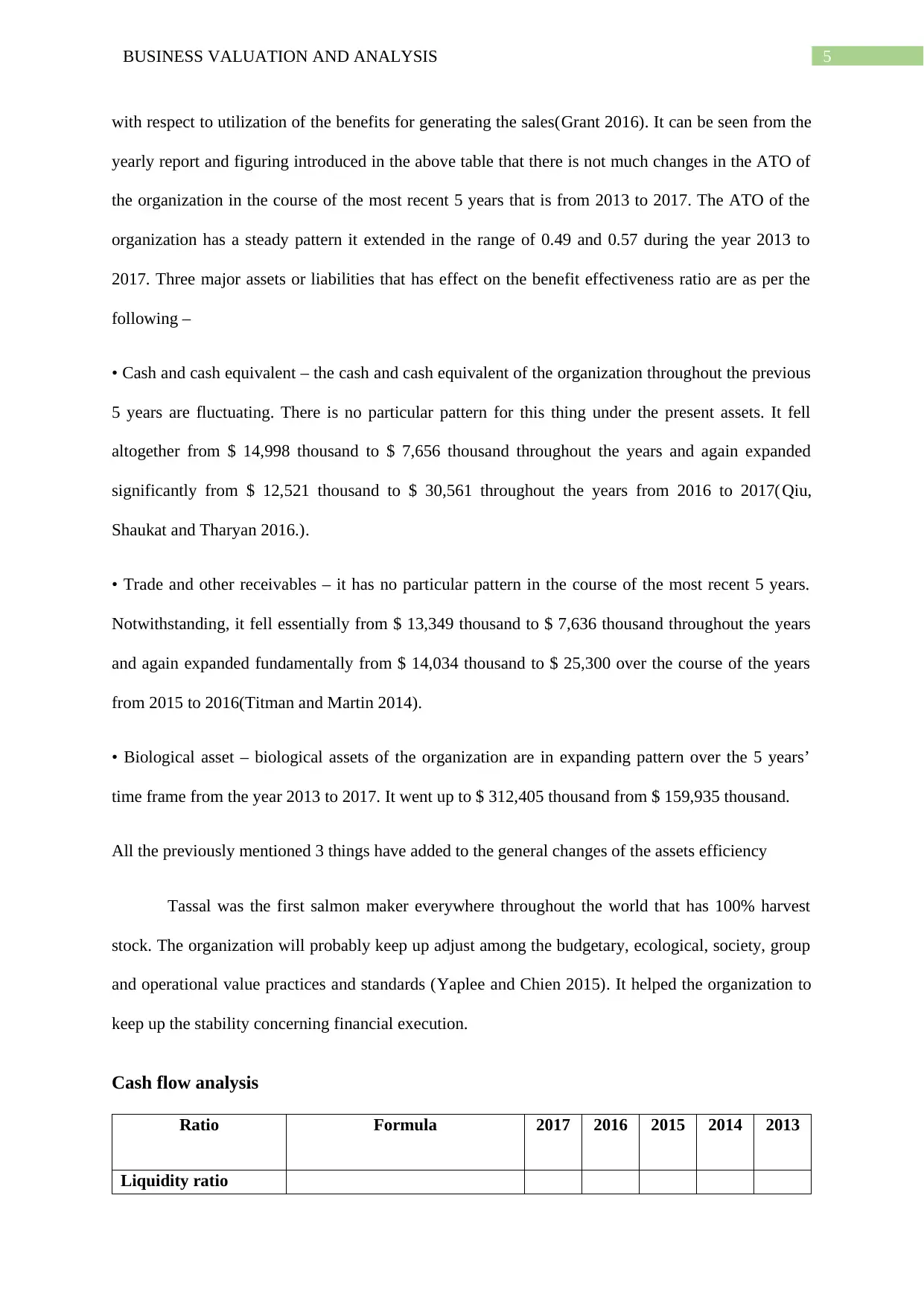
5BUSINESS VALUATION AND ANALYSIS
with respect to utilization of the benefits for generating the sales(Grant 2016). It can be seen from the
yearly report and figuring introduced in the above table that there is not much changes in the ATO of
the organization in the course of the most recent 5 years that is from 2013 to 2017. The ATO of the
organization has a steady pattern it extended in the range of 0.49 and 0.57 during the year 2013 to
2017. Three major assets or liabilities that has effect on the benefit effectiveness ratio are as per the
following –
• Cash and cash equivalent – the cash and cash equivalent of the organization throughout the previous
5 years are fluctuating. There is no particular pattern for this thing under the present assets. It fell
altogether from $ 14,998 thousand to $ 7,656 thousand throughout the years and again expanded
significantly from $ 12,521 thousand to $ 30,561 throughout the years from 2016 to 2017(Qiu,
Shaukat and Tharyan 2016.).
• Trade and other receivables – it has no particular pattern in the course of the most recent 5 years.
Notwithstanding, it fell essentially from $ 13,349 thousand to $ 7,636 thousand throughout the years
and again expanded fundamentally from $ 14,034 thousand to $ 25,300 over the course of the years
from 2015 to 2016(Titman and Martin 2014).
• Biological asset – biological assets of the organization are in expanding pattern over the 5 years’
time frame from the year 2013 to 2017. It went up to $ 312,405 thousand from $ 159,935 thousand.
All the previously mentioned 3 things have added to the general changes of the assets efficiency
Tassal was the first salmon maker everywhere throughout the world that has 100% harvest
stock. The organization will probably keep up adjust among the budgetary, ecological, society, group
and operational value practices and standards (Yaplee and Chien 2015). It helped the organization to
keep up the stability concerning financial execution.
Cash flow analysis
Ratio Formula 2017 2016 2015 2014 2013
Liquidity ratio
with respect to utilization of the benefits for generating the sales(Grant 2016). It can be seen from the
yearly report and figuring introduced in the above table that there is not much changes in the ATO of
the organization in the course of the most recent 5 years that is from 2013 to 2017. The ATO of the
organization has a steady pattern it extended in the range of 0.49 and 0.57 during the year 2013 to
2017. Three major assets or liabilities that has effect on the benefit effectiveness ratio are as per the
following –
• Cash and cash equivalent – the cash and cash equivalent of the organization throughout the previous
5 years are fluctuating. There is no particular pattern for this thing under the present assets. It fell
altogether from $ 14,998 thousand to $ 7,656 thousand throughout the years and again expanded
significantly from $ 12,521 thousand to $ 30,561 throughout the years from 2016 to 2017(Qiu,
Shaukat and Tharyan 2016.).
• Trade and other receivables – it has no particular pattern in the course of the most recent 5 years.
Notwithstanding, it fell essentially from $ 13,349 thousand to $ 7,636 thousand throughout the years
and again expanded fundamentally from $ 14,034 thousand to $ 25,300 over the course of the years
from 2015 to 2016(Titman and Martin 2014).
• Biological asset – biological assets of the organization are in expanding pattern over the 5 years’
time frame from the year 2013 to 2017. It went up to $ 312,405 thousand from $ 159,935 thousand.
All the previously mentioned 3 things have added to the general changes of the assets efficiency
Tassal was the first salmon maker everywhere throughout the world that has 100% harvest
stock. The organization will probably keep up adjust among the budgetary, ecological, society, group
and operational value practices and standards (Yaplee and Chien 2015). It helped the organization to
keep up the stability concerning financial execution.
Cash flow analysis
Ratio Formula 2017 2016 2015 2014 2013
Liquidity ratio
⊘ This is a preview!⊘
Do you want full access?
Subscribe today to unlock all pages.

Trusted by 1+ million students worldwide
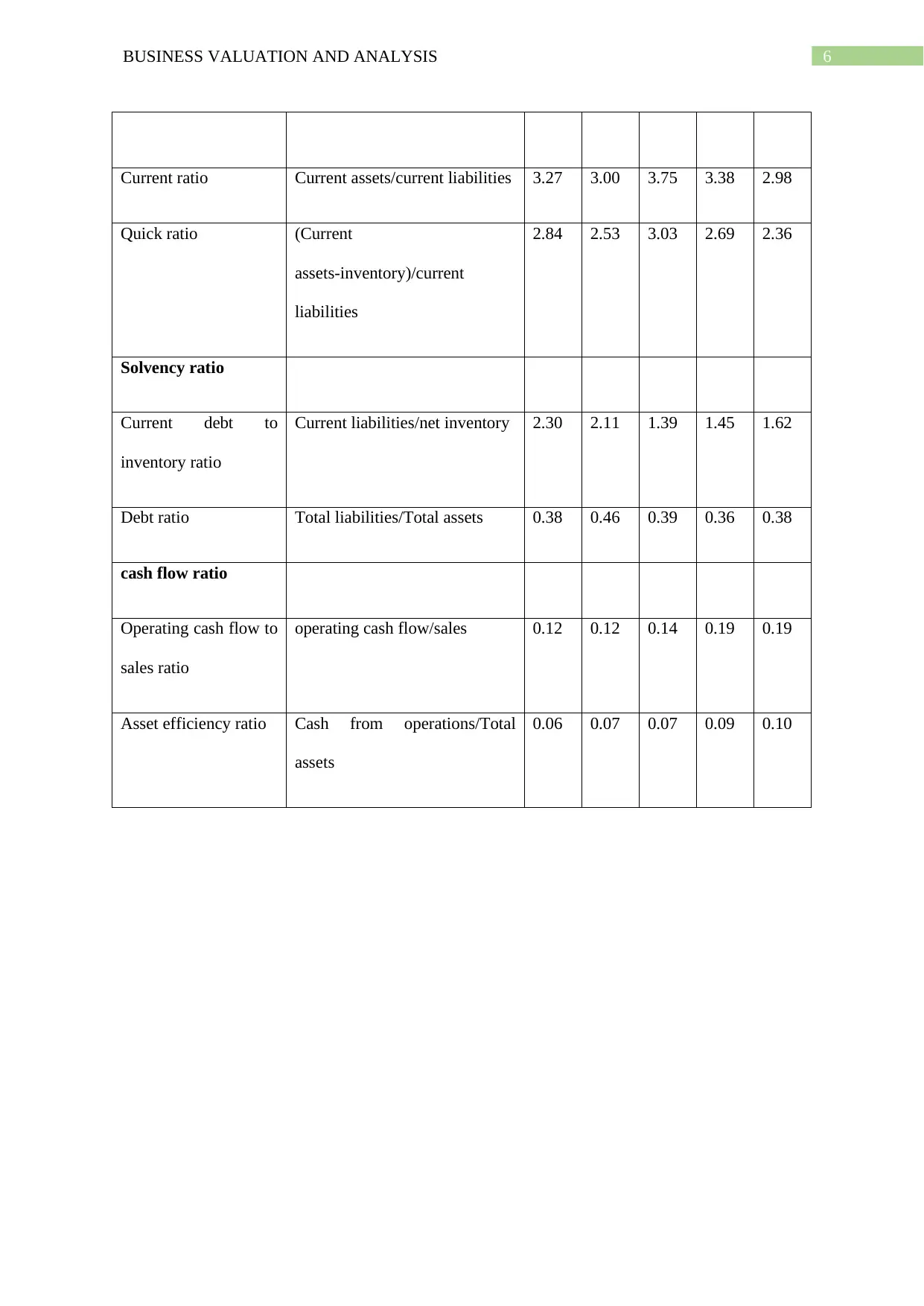
6BUSINESS VALUATION AND ANALYSIS
Current ratio Current assets/current liabilities 3.27 3.00 3.75 3.38 2.98
Quick ratio (Current
assets-inventory)/current
liabilities
2.84 2.53 3.03 2.69 2.36
Solvency ratio
Current debt to
inventory ratio
Current liabilities/net inventory 2.30 2.11 1.39 1.45 1.62
Debt ratio Total liabilities/Total assets 0.38 0.46 0.39 0.36 0.38
cash flow ratio
Operating cash flow to
sales ratio
operating cash flow/sales 0.12 0.12 0.14 0.19 0.19
Asset efficiency ratio Cash from operations/Total
assets
0.06 0.07 0.07 0.09 0.10
Current ratio Current assets/current liabilities 3.27 3.00 3.75 3.38 2.98
Quick ratio (Current
assets-inventory)/current
liabilities
2.84 2.53 3.03 2.69 2.36
Solvency ratio
Current debt to
inventory ratio
Current liabilities/net inventory 2.30 2.11 1.39 1.45 1.62
Debt ratio Total liabilities/Total assets 0.38 0.46 0.39 0.36 0.38
cash flow ratio
Operating cash flow to
sales ratio
operating cash flow/sales 0.12 0.12 0.14 0.19 0.19
Asset efficiency ratio Cash from operations/Total
assets
0.06 0.07 0.07 0.09 0.10
Paraphrase This Document
Need a fresh take? Get an instant paraphrase of this document with our AI Paraphraser
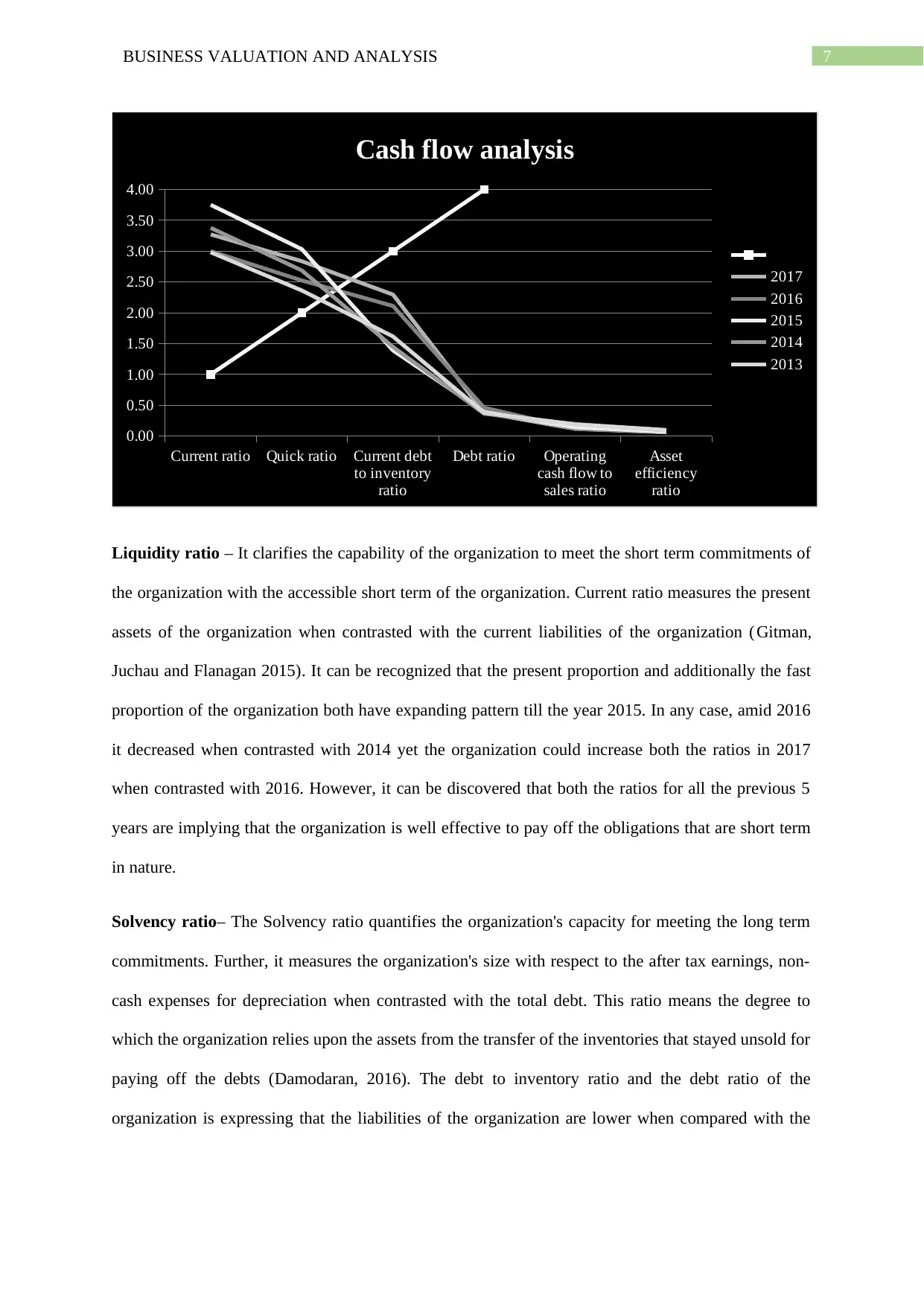
7BUSINESS VALUATION AND ANALYSIS
Current ratio Quick ratio Current debt
to inventory
ratio
Debt ratio Operating
cash flow to
sales ratio
Asset
efficiency
ratio
0.00
0.50
1.00
1.50
2.00
2.50
3.00
3.50
4.00
Cash flow analysis
2017
2016
2015
2014
2013
Liquidity ratio – It clarifies the capability of the organization to meet the short term commitments of
the organization with the accessible short term of the organization. Current ratio measures the present
assets of the organization when contrasted with the current liabilities of the organization (Gitman,
Juchau and Flanagan 2015). It can be recognized that the present proportion and additionally the fast
proportion of the organization both have expanding pattern till the year 2015. In any case, amid 2016
it decreased when contrasted with 2014 yet the organization could increase both the ratios in 2017
when contrasted with 2016. However, it can be discovered that both the ratios for all the previous 5
years are implying that the organization is well effective to pay off the obligations that are short term
in nature.
Solvency ratio– The Solvency ratio quantifies the organization's capacity for meeting the long term
commitments. Further, it measures the organization's size with respect to the after tax earnings, non-
cash expenses for depreciation when contrasted with the total debt. This ratio means the degree to
which the organization relies upon the assets from the transfer of the inventories that stayed unsold for
paying off the debts (Damodaran, 2016). The debt to inventory ratio and the debt ratio of the
organization is expressing that the liabilities of the organization are lower when compared with the
Current ratio Quick ratio Current debt
to inventory
ratio
Debt ratio Operating
cash flow to
sales ratio
Asset
efficiency
ratio
0.00
0.50
1.00
1.50
2.00
2.50
3.00
3.50
4.00
Cash flow analysis
2017
2016
2015
2014
2013
Liquidity ratio – It clarifies the capability of the organization to meet the short term commitments of
the organization with the accessible short term of the organization. Current ratio measures the present
assets of the organization when contrasted with the current liabilities of the organization (Gitman,
Juchau and Flanagan 2015). It can be recognized that the present proportion and additionally the fast
proportion of the organization both have expanding pattern till the year 2015. In any case, amid 2016
it decreased when contrasted with 2014 yet the organization could increase both the ratios in 2017
when contrasted with 2016. However, it can be discovered that both the ratios for all the previous 5
years are implying that the organization is well effective to pay off the obligations that are short term
in nature.
Solvency ratio– The Solvency ratio quantifies the organization's capacity for meeting the long term
commitments. Further, it measures the organization's size with respect to the after tax earnings, non-
cash expenses for depreciation when contrasted with the total debt. This ratio means the degree to
which the organization relies upon the assets from the transfer of the inventories that stayed unsold for
paying off the debts (Damodaran, 2016). The debt to inventory ratio and the debt ratio of the
organization is expressing that the liabilities of the organization are lower when compared with the
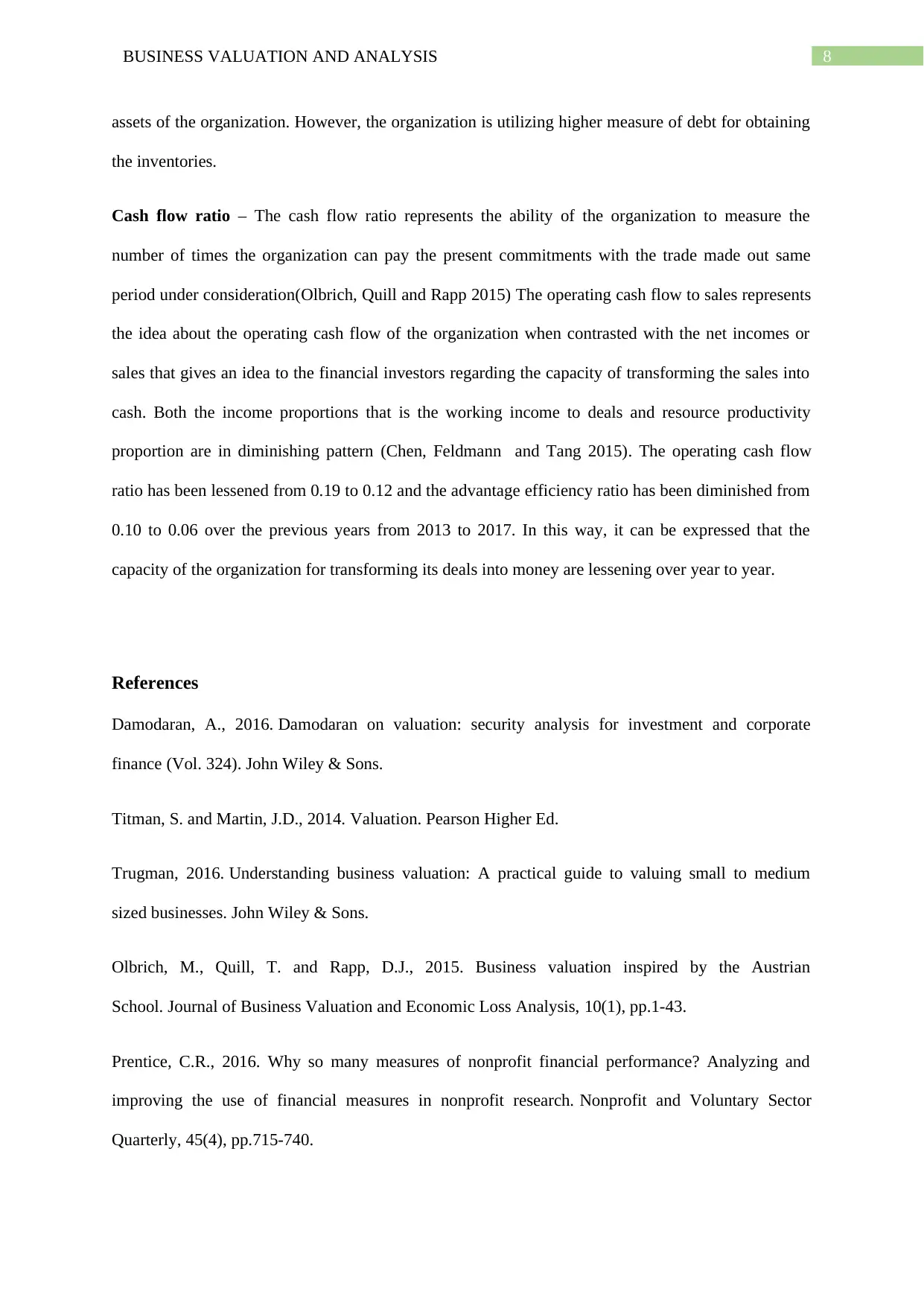
8BUSINESS VALUATION AND ANALYSIS
assets of the organization. However, the organization is utilizing higher measure of debt for obtaining
the inventories.
Cash flow ratio – The cash flow ratio represents the ability of the organization to measure the
number of times the organization can pay the present commitments with the trade made out same
period under consideration(Olbrich, Quill and Rapp 2015) The operating cash flow to sales represents
the idea about the operating cash flow of the organization when contrasted with the net incomes or
sales that gives an idea to the financial investors regarding the capacity of transforming the sales into
cash. Both the income proportions that is the working income to deals and resource productivity
proportion are in diminishing pattern (Chen, Feldmann and Tang 2015). The operating cash flow
ratio has been lessened from 0.19 to 0.12 and the advantage efficiency ratio has been diminished from
0.10 to 0.06 over the previous years from 2013 to 2017. In this way, it can be expressed that the
capacity of the organization for transforming its deals into money are lessening over year to year.
References
Damodaran, A., 2016. Damodaran on valuation: security analysis for investment and corporate
finance (Vol. 324). John Wiley & Sons.
Titman, S. and Martin, J.D., 2014. Valuation. Pearson Higher Ed.
Trugman, 2016. Understanding business valuation: A practical guide to valuing small to medium
sized businesses. John Wiley & Sons.
Olbrich, M., Quill, T. and Rapp, D.J., 2015. Business valuation inspired by the Austrian
School. Journal of Business Valuation and Economic Loss Analysis, 10(1), pp.1-43.
Prentice, C.R., 2016. Why so many measures of nonprofit financial performance? Analyzing and
improving the use of financial measures in nonprofit research. Nonprofit and Voluntary Sector
Quarterly, 45(4), pp.715-740.
assets of the organization. However, the organization is utilizing higher measure of debt for obtaining
the inventories.
Cash flow ratio – The cash flow ratio represents the ability of the organization to measure the
number of times the organization can pay the present commitments with the trade made out same
period under consideration(Olbrich, Quill and Rapp 2015) The operating cash flow to sales represents
the idea about the operating cash flow of the organization when contrasted with the net incomes or
sales that gives an idea to the financial investors regarding the capacity of transforming the sales into
cash. Both the income proportions that is the working income to deals and resource productivity
proportion are in diminishing pattern (Chen, Feldmann and Tang 2015). The operating cash flow
ratio has been lessened from 0.19 to 0.12 and the advantage efficiency ratio has been diminished from
0.10 to 0.06 over the previous years from 2013 to 2017. In this way, it can be expressed that the
capacity of the organization for transforming its deals into money are lessening over year to year.
References
Damodaran, A., 2016. Damodaran on valuation: security analysis for investment and corporate
finance (Vol. 324). John Wiley & Sons.
Titman, S. and Martin, J.D., 2014. Valuation. Pearson Higher Ed.
Trugman, 2016. Understanding business valuation: A practical guide to valuing small to medium
sized businesses. John Wiley & Sons.
Olbrich, M., Quill, T. and Rapp, D.J., 2015. Business valuation inspired by the Austrian
School. Journal of Business Valuation and Economic Loss Analysis, 10(1), pp.1-43.
Prentice, C.R., 2016. Why so many measures of nonprofit financial performance? Analyzing and
improving the use of financial measures in nonprofit research. Nonprofit and Voluntary Sector
Quarterly, 45(4), pp.715-740.
⊘ This is a preview!⊘
Do you want full access?
Subscribe today to unlock all pages.

Trusted by 1+ million students worldwide
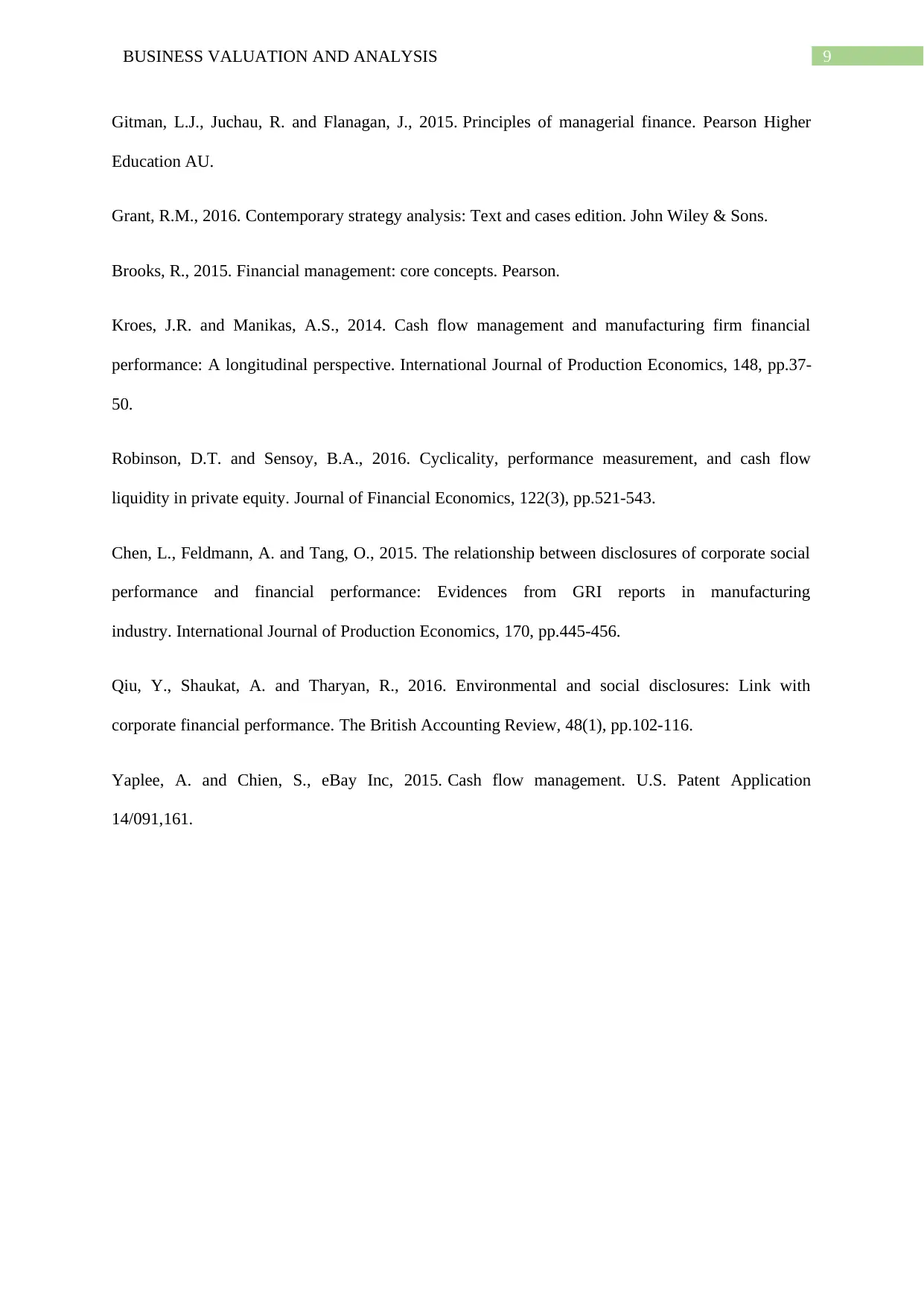
9BUSINESS VALUATION AND ANALYSIS
Gitman, L.J., Juchau, R. and Flanagan, J., 2015. Principles of managerial finance. Pearson Higher
Education AU.
Grant, R.M., 2016. Contemporary strategy analysis: Text and cases edition. John Wiley & Sons.
Brooks, R., 2015. Financial management: core concepts. Pearson.
Kroes, J.R. and Manikas, A.S., 2014. Cash flow management and manufacturing firm financial
performance: A longitudinal perspective. International Journal of Production Economics, 148, pp.37-
50.
Robinson, D.T. and Sensoy, B.A., 2016. Cyclicality, performance measurement, and cash flow
liquidity in private equity. Journal of Financial Economics, 122(3), pp.521-543.
Chen, L., Feldmann, A. and Tang, O., 2015. The relationship between disclosures of corporate social
performance and financial performance: Evidences from GRI reports in manufacturing
industry. International Journal of Production Economics, 170, pp.445-456.
Qiu, Y., Shaukat, A. and Tharyan, R., 2016. Environmental and social disclosures: Link with
corporate financial performance. The British Accounting Review, 48(1), pp.102-116.
Yaplee, A. and Chien, S., eBay Inc, 2015. Cash flow management. U.S. Patent Application
14/091,161.
Gitman, L.J., Juchau, R. and Flanagan, J., 2015. Principles of managerial finance. Pearson Higher
Education AU.
Grant, R.M., 2016. Contemporary strategy analysis: Text and cases edition. John Wiley & Sons.
Brooks, R., 2015. Financial management: core concepts. Pearson.
Kroes, J.R. and Manikas, A.S., 2014. Cash flow management and manufacturing firm financial
performance: A longitudinal perspective. International Journal of Production Economics, 148, pp.37-
50.
Robinson, D.T. and Sensoy, B.A., 2016. Cyclicality, performance measurement, and cash flow
liquidity in private equity. Journal of Financial Economics, 122(3), pp.521-543.
Chen, L., Feldmann, A. and Tang, O., 2015. The relationship between disclosures of corporate social
performance and financial performance: Evidences from GRI reports in manufacturing
industry. International Journal of Production Economics, 170, pp.445-456.
Qiu, Y., Shaukat, A. and Tharyan, R., 2016. Environmental and social disclosures: Link with
corporate financial performance. The British Accounting Review, 48(1), pp.102-116.
Yaplee, A. and Chien, S., eBay Inc, 2015. Cash flow management. U.S. Patent Application
14/091,161.
Paraphrase This Document
Need a fresh take? Get an instant paraphrase of this document with our AI Paraphraser
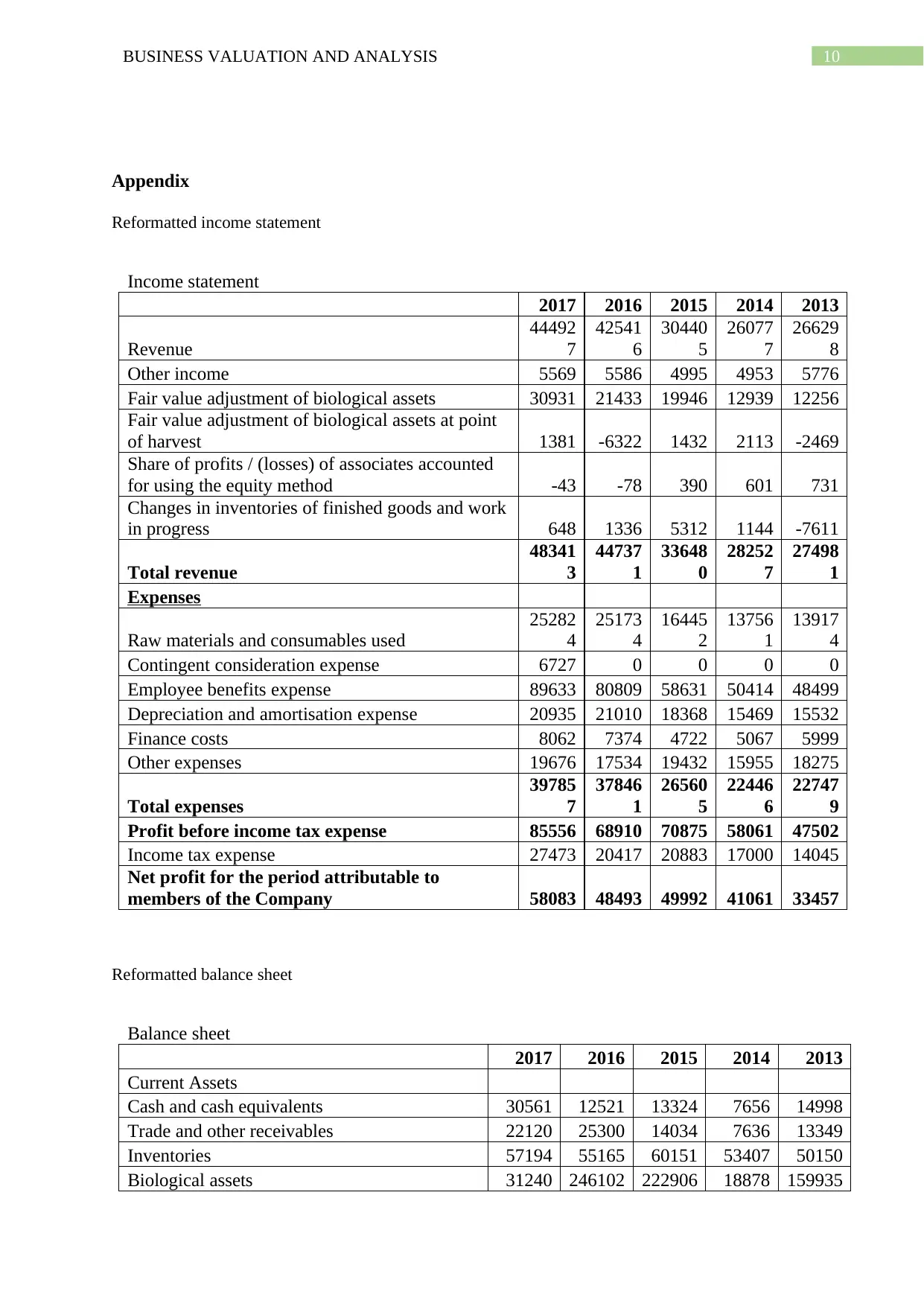
10BUSINESS VALUATION AND ANALYSIS
Appendix
Reformatted income statement
Income statement
2017 2016 2015 2014 2013
Revenue
44492
7
42541
6
30440
5
26077
7
26629
8
Other income 5569 5586 4995 4953 5776
Fair value adjustment of biological assets 30931 21433 19946 12939 12256
Fair value adjustment of biological assets at point
of harvest 1381 -6322 1432 2113 -2469
Share of profits / (losses) of associates accounted
for using the equity method -43 -78 390 601 731
Changes in inventories of finished goods and work
in progress 648 1336 5312 1144 -7611
Total revenue
48341
3
44737
1
33648
0
28252
7
27498
1
Expenses
Raw materials and consumables used
25282
4
25173
4
16445
2
13756
1
13917
4
Contingent consideration expense 6727 0 0 0 0
Employee benefits expense 89633 80809 58631 50414 48499
Depreciation and amortisation expense 20935 21010 18368 15469 15532
Finance costs 8062 7374 4722 5067 5999
Other expenses 19676 17534 19432 15955 18275
Total expenses
39785
7
37846
1
26560
5
22446
6
22747
9
Profit before income tax expense 85556 68910 70875 58061 47502
Income tax expense 27473 20417 20883 17000 14045
Net profit for the period attributable to
members of the Company 58083 48493 49992 41061 33457
Reformatted balance sheet
Balance sheet
2017 2016 2015 2014 2013
Current Assets
Cash and cash equivalents 30561 12521 13324 7656 14998
Trade and other receivables 22120 25300 14034 7636 13349
Inventories 57194 55165 60151 53407 50150
Biological assets 31240 246102 222906 18878 159935
Appendix
Reformatted income statement
Income statement
2017 2016 2015 2014 2013
Revenue
44492
7
42541
6
30440
5
26077
7
26629
8
Other income 5569 5586 4995 4953 5776
Fair value adjustment of biological assets 30931 21433 19946 12939 12256
Fair value adjustment of biological assets at point
of harvest 1381 -6322 1432 2113 -2469
Share of profits / (losses) of associates accounted
for using the equity method -43 -78 390 601 731
Changes in inventories of finished goods and work
in progress 648 1336 5312 1144 -7611
Total revenue
48341
3
44737
1
33648
0
28252
7
27498
1
Expenses
Raw materials and consumables used
25282
4
25173
4
16445
2
13756
1
13917
4
Contingent consideration expense 6727 0 0 0 0
Employee benefits expense 89633 80809 58631 50414 48499
Depreciation and amortisation expense 20935 21010 18368 15469 15532
Finance costs 8062 7374 4722 5067 5999
Other expenses 19676 17534 19432 15955 18275
Total expenses
39785
7
37846
1
26560
5
22446
6
22747
9
Profit before income tax expense 85556 68910 70875 58061 47502
Income tax expense 27473 20417 20883 17000 14045
Net profit for the period attributable to
members of the Company 58083 48493 49992 41061 33457
Reformatted balance sheet
Balance sheet
2017 2016 2015 2014 2013
Current Assets
Cash and cash equivalents 30561 12521 13324 7656 14998
Trade and other receivables 22120 25300 14034 7636 13349
Inventories 57194 55165 60151 53407 50150
Biological assets 31240 246102 222906 18878 159935

11BUSINESS VALUATION AND ANALYSIS
5 4
Other financial assets 868 3724 448 448 868
Other 6559 6396 2740 3051 2395
Total Current Assets
42970
7 349208 313603
26098
2 241695
Non-Current Assets
Investments accounted for using the equity
method 8549 8592 8670 8280 7679
Other financial assets 2627 49 60 71 82
Property, plant and equipment
31035
5 279967 247174
22495
7 217831
Goodwill 82306 82306 14851 14851 14851
Other intangible assets 24184 24184 24184 24184 24184
Other 5021 4765 4385 3220 462
Total Non-Current Assets
43304
2 399863 299324
27556
3 265089
Total Assets
86274
9 749071 612927
53654
5 506784
Current Liabilities
Trade and other payables 78670 61870 58257 46099 42930
Borrowings 29998 27137 17765 23186 30674
Current tax liability 4415 10916 1930 1500 1003
Contingent consideration 7980 8635 5384 5922 5542
Provisions 9788 6850 232 260 204
Other financial liabilities 470 1038 14 291 720
Total Current Liabilities
13132
1 116446 83582 77258 81073
Non-Current Liabilities
Borrowings 67388 120754 61273 37144 42399
Deferred tax liabilities
11736
4 97791 93508 79145 66859
Deferred and contingent consideration 6984 8152 0 0 0
Provisions 1798 1592 1231 1075 906
Total Non-Current Liabilities
19353
4 228289 156012
11736
4 110164
Total Liabilities
32485
5 344735 239594
19462
2 191237
Net Assets
53789
4 404336 373333
34192
3 315547
Equity
Issued capital
25390
5 154983 154647
15421
3 154027
Reserves 13864 13513 9995 9914 9401
Retained earnings
27012
5 235840 208691
17779
6 152119
Total Equity
53789
4 404336 373333
34192
3 315547
5 4
Other financial assets 868 3724 448 448 868
Other 6559 6396 2740 3051 2395
Total Current Assets
42970
7 349208 313603
26098
2 241695
Non-Current Assets
Investments accounted for using the equity
method 8549 8592 8670 8280 7679
Other financial assets 2627 49 60 71 82
Property, plant and equipment
31035
5 279967 247174
22495
7 217831
Goodwill 82306 82306 14851 14851 14851
Other intangible assets 24184 24184 24184 24184 24184
Other 5021 4765 4385 3220 462
Total Non-Current Assets
43304
2 399863 299324
27556
3 265089
Total Assets
86274
9 749071 612927
53654
5 506784
Current Liabilities
Trade and other payables 78670 61870 58257 46099 42930
Borrowings 29998 27137 17765 23186 30674
Current tax liability 4415 10916 1930 1500 1003
Contingent consideration 7980 8635 5384 5922 5542
Provisions 9788 6850 232 260 204
Other financial liabilities 470 1038 14 291 720
Total Current Liabilities
13132
1 116446 83582 77258 81073
Non-Current Liabilities
Borrowings 67388 120754 61273 37144 42399
Deferred tax liabilities
11736
4 97791 93508 79145 66859
Deferred and contingent consideration 6984 8152 0 0 0
Provisions 1798 1592 1231 1075 906
Total Non-Current Liabilities
19353
4 228289 156012
11736
4 110164
Total Liabilities
32485
5 344735 239594
19462
2 191237
Net Assets
53789
4 404336 373333
34192
3 315547
Equity
Issued capital
25390
5 154983 154647
15421
3 154027
Reserves 13864 13513 9995 9914 9401
Retained earnings
27012
5 235840 208691
17779
6 152119
Total Equity
53789
4 404336 373333
34192
3 315547
⊘ This is a preview!⊘
Do you want full access?
Subscribe today to unlock all pages.

Trusted by 1+ million students worldwide
1 out of 13
Related Documents
Your All-in-One AI-Powered Toolkit for Academic Success.
+13062052269
info@desklib.com
Available 24*7 on WhatsApp / Email
![[object Object]](/_next/static/media/star-bottom.7253800d.svg)
Unlock your academic potential
Copyright © 2020–2025 A2Z Services. All Rights Reserved. Developed and managed by ZUCOL.





